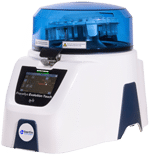- Productsarrow
- Products
Life Sciencesarrow
- Life Sciences
- Sample Preparation – Homogenizersarrow
- Sample Preparation – Homogenizers
- Precellys Evolution Touch Homogenizer
- Precellys 24 Touch Homogenizerarrow
- Precellys Nucleic Acid Extraction Kitsarrow
- Precellys Multi-Tissue Dissociation Kit
- Lysing Kitsarrow
- Minilys Personal Homogenizerarrow
- Cryolys Evolutionarrow
- Bioreagent & Bioanalytical Toolsarrow
- Bioreagent & Bioanalytical Tools
- Assay Kitsarrow
- Precellys Nucleic Acid Extraction Kitsarrow
- Precellys Multi-Tissue Dissociation Kit
- Antibodiesarrow
- Biotoxisarrow
- Air Monitoringarrow
- Air Monitoring
- Coriolis Compactarrow
- Coriolis Microarrow
- Coriolis Consumables
- Coriolis Connect
- Cleapart-100arrow
- Applicationsarrow
- Applications
- Acetylcholinesterase (AChE) Technologyarrow
- Bacteria Detectionarrow
- Protein Extraction
- RNA Extraction
- Metabolite Extraction
- Choosing Your Lysing Kit
- Drug Extraction
- Emulsion Kit
- PCR & RT-PCR
- NGS
- Western Blot
- Mass Spectrometry
- ELISA
- Chromatography
- Acetylcholinesterase (AChE) Technology
- DNA Extraction
- Fungi Detectionarrow
- Virus Detectionarrow
- Evaluation of Decontaminationarrow
- Allergen Detectionarrow
- On-Demand Systems
- On-Demand Systems
- Automated Cardiac Stem Cell Production
- BEC SARS-COV-2 RT-LAMP KIT
- Electroporator
Nuclear Detection & Health Physicsarrow
- Nuclear Detection & Health Physics
- Health Physicsarrow
- Health Physics
- Contamination meters
- SaphyRAD Carrow
- Survey Metersarrow
- Dosimetryarrow
- BAB A7
- Environmental Radiation Monitoringarrow
- Environmental Radiation Monitoring
- GammaTRACER – Radiation Monitor
- SpectroTRACER – Spectrometric Probe
- BAB E
- Radiation Portal Monitorsarrow
- Radiation Portal Monitors
- SaphyGATE G
- SaphyGATE GN
- Radon Monitoring – Detection & Meterarrow
- Radon Monitoring – Detection & Meter
- AlphaGUARD – Radon Monitor
- AlphaE – Ultra-Small Radon Monitor
- Servicesarrow
- Services
- Installation & Commissioningarrow
- Trainingarrow
- Metrologyarrow
- Maintenancearrow
- Equipments Managementarrow
- Spare Partsarrow
- Applicationsarrow
- On-Demand Systems
CBRNarrow
- CBRN
- Chemical Detectionarrow
- Biological Sampling & Identificationarrow
- Radiological Detection & Monitoring Solutionsarrow
- Applicationsarrow
- On-Demand Systems
- On-Demand Systems
- 2SNM – Radiation detection & monitoring system for naval bases
Surveillance & Protectionarrow
- Surveillance & Protection
- Unattended Ground Sensors (UGS)
- Unattended Ground Sensors (UGS)
- Flexnet – Wireless protection & surveillance system
- Optronics
- Optics
- Components
- Components
- High precision optical components
- Applicationsarrow
- On-Demand Systems
- On-Demand Systems
- Carrying out surveillance & gathering intelligence with Camsight LP integrated into the Flexnet solution
- Driver vision enhancement on the light armored vehicle Scarabee of ARQUUS
- Implementing a situation awareness system for the SPRAT rapid bridge installation system of CNIM
- Improving long-range night & day surveillance with Camsight LP and tethered aerostat White Hawk
Medical Waste Managementarrow
- Medical Waste Management
- Medical Waste Treatment Solutions
- Medical Waste Treatment Solutions
- Sterilwave 100
- Sterilwave 250
- Sterilwave 440
- Detecting Radioactivity in Medical Waste
- Detecting Radioactivity in Medical Waste
- Contamination Meters
- Radiation Portal Monitorsarrow
- Applicationsarrow
Space & Big Sciencearrow
- Space & Big Science
- Space
- Fusionarrow
- Astronomyarrow
- Synchrotron / X-Rayarrow
- Synchrotron / X-Ray
- KB Kirkpatrick-Baez Systems
- X-ray Mirror Benders
- X-ray Mirrors
- Expertisearrow
- Resourcesarrow
- Newsarrow
- About usarrow
- About us
 Who we are?
Who we are? Governance
Governance Business Unitsarrow
Business Unitsarrow
 Subsidiariesarrow
Subsidiariesarrow
- Subsidiaries
- Bertin Corp.
- Bertin Environics
- Bertin Exensor
- Bertin GmbH
- Bertin Italia
 Our locations
Our locations Certifications
Certifications
- Contactarrow
PCR and RT-PCR
PCR is a vital analytical tool for modern biologists. The success of PCR workflows is highly dependent on the quantity, purity, and degree of fragmentation of the DNA. Here, Bertin’s top scientists have presented examples of optimized homogenization protocols to obtain high quality nucleic acids and guarantee the success of your PCR workflow.
PCR (polymerase chain reaction) is a widely used method to amplify DNA. It has a wide range of applications including biomedical research and forensic science. PCR sample preparation varies according to the type of sample and the type of PCR. For most tissue samples, PCR workflows start with a homogenization step. Several studies have shown that the choice of homogenization method strongly impacts PCR and RT-PCR results, for example in the context of MERS-CoV detection (1. Sung & al. in 2016). To achieve reliable results, PCR workflows require efficient homogenization in order to maximize nucleic acid recovery and fragment size. This can be challenging, as some sample types possess structural and rheological properties that can impede standardization of the homogenization step. The Precellys tissue homogenizers offer a reproducible, high throughput solution for researchers aiming to optimize their PCR workflows.
In the following application notes, you will find helpful information about how to obtain high-yield, high-quality nucleic acids with our Precellys device and how to optimize your PCR workflows. The Precellys tissue homogenizers are available in high-throughput format to process up to 24 samples simultaneously. Our high-throughput Precellys models can process 200 samples in 30 minutes, saving valuable time for researchers.
(1) Sung, H., Yong, D., Ki, C. S., Kim, J. S., Seong, M. W., Lee, H., & Kim, M. N. (2016). Comparative evaluation of three homogenization methods for isolating Middle East respiratory syndrome coronavirus nucleic acids from sputum samples for real-time reverse transcription PCR. Annals of laboratory medicine, 36(5), 457-462.
ANY QUESTIONS? CONTACT AN EXPERT
Please fill in this form if you wish to contact our sales team or receive further information.




